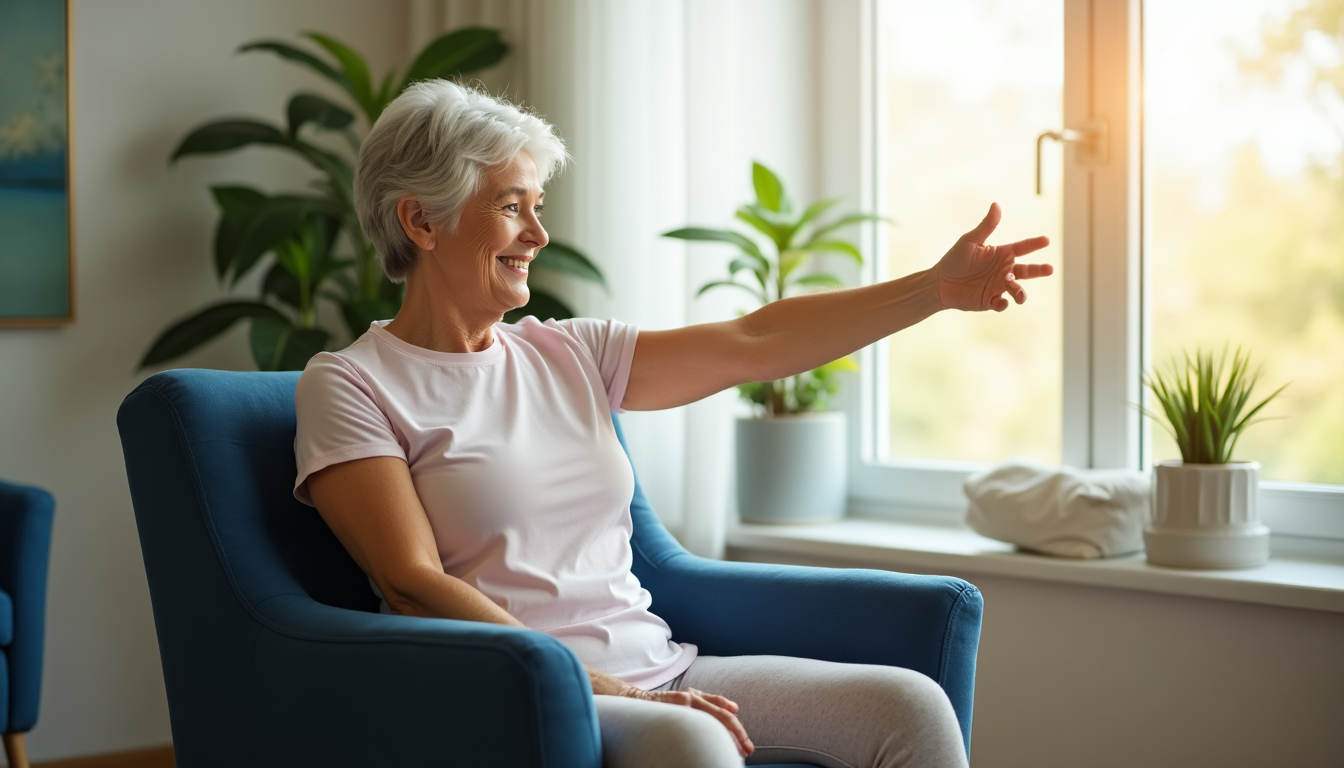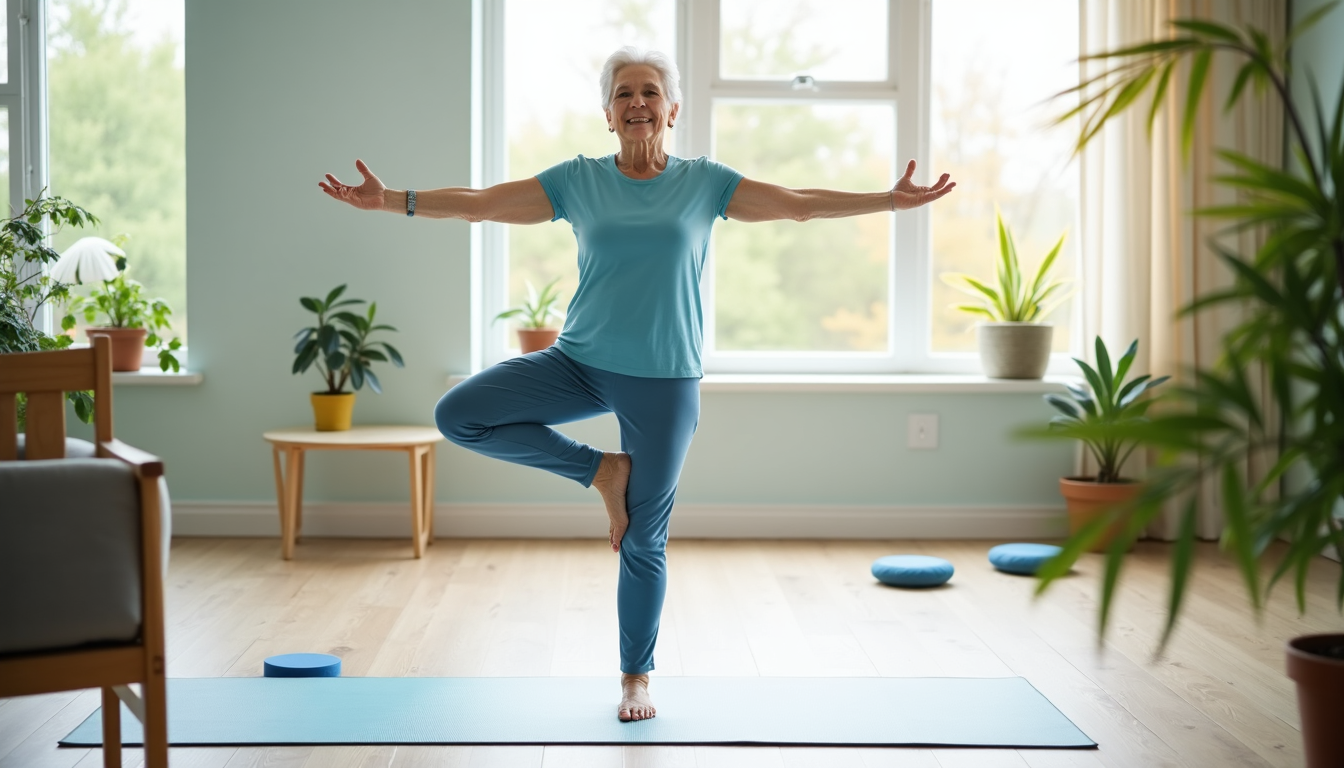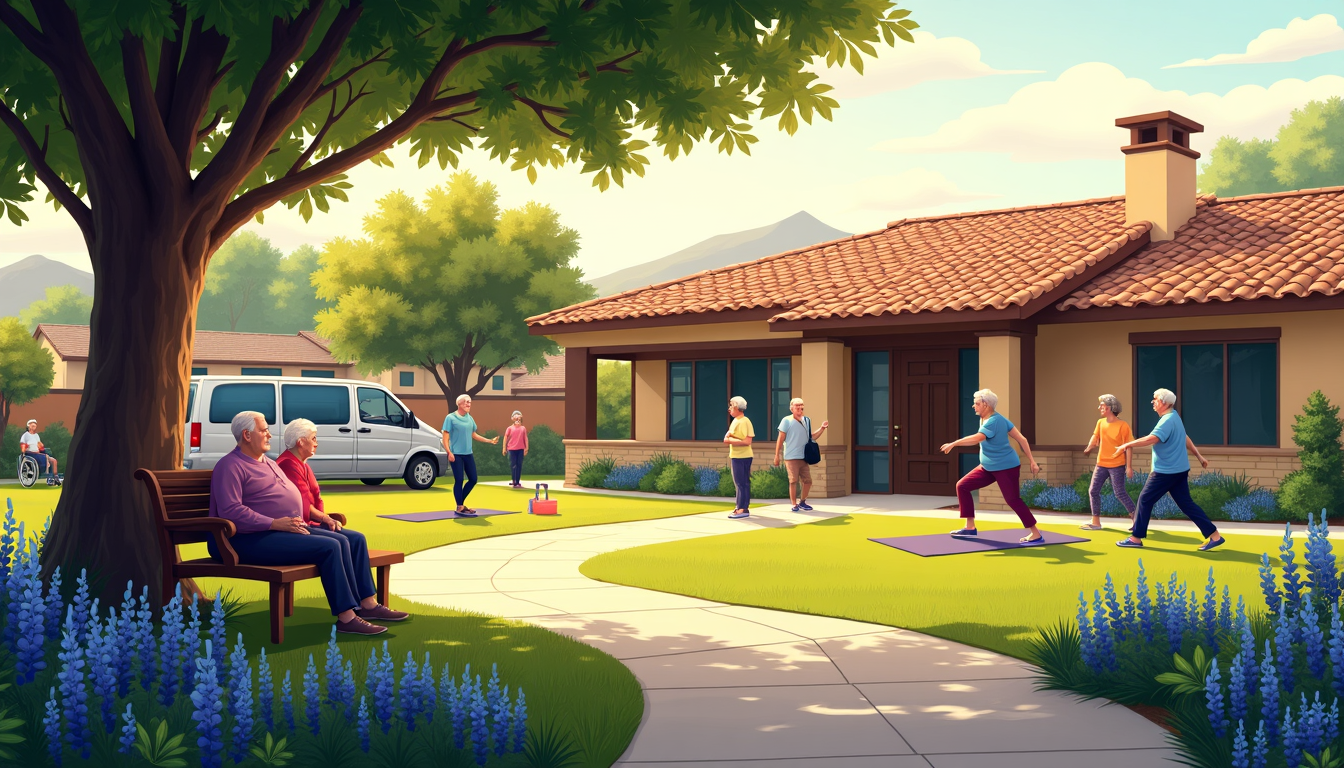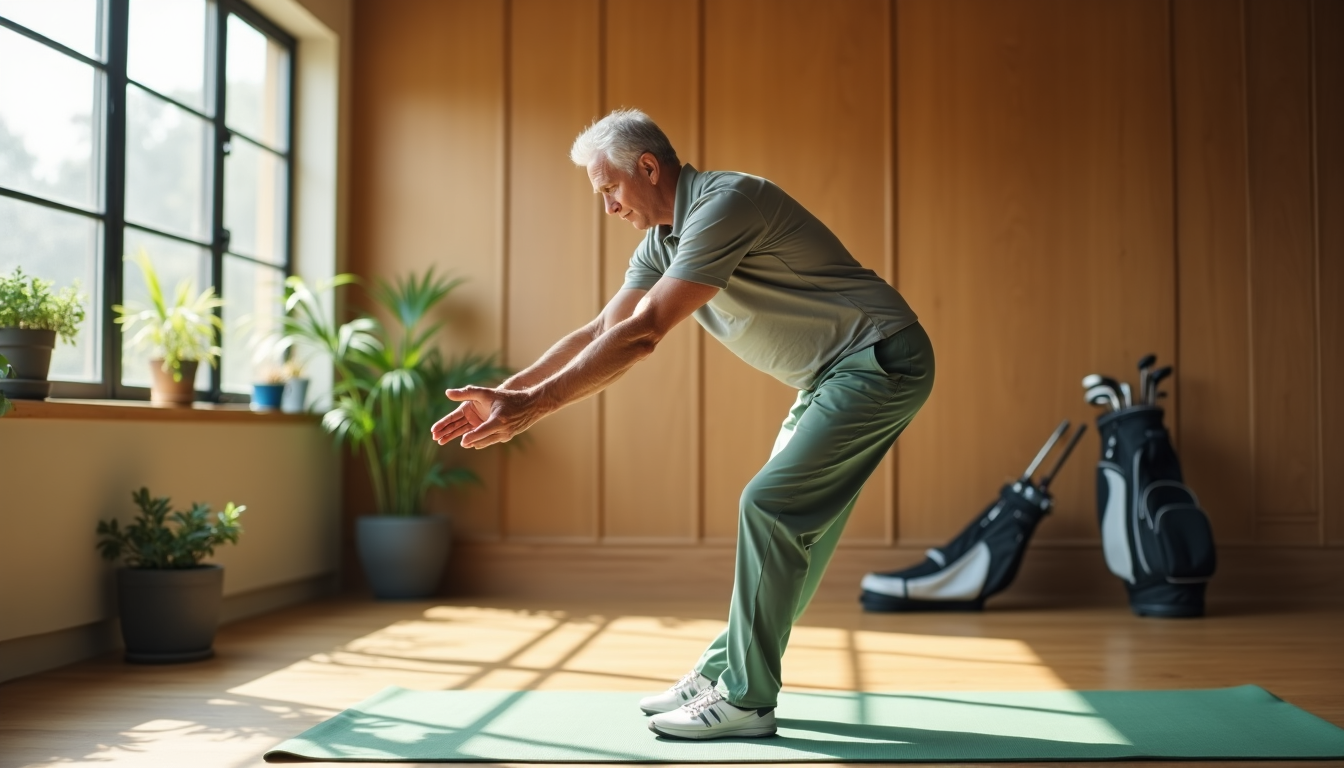Ring in Care: Daily check-in calls for seniors and loved ones
Get StartedDid you know that 36% of adults aged 65 and older struggle with mobility in their daily activities?
Here’s something encouraging – staying active and mobile doesn’t require expensive gym equipment or intense workouts. Chair exercises for seniors are a great way to maintain strength and flexibility from your home’s comfort.
Starting a new exercise routine might feel overwhelming at first. This piece provides a complete guide to simple chair exercises for seniors. These seated exercises will help you build strength, improve balance, and boost your overall mobility while you stay safely seated.
You can achieve your fitness goals with these easy chair exercises, whether you want to improve your daily movements or stay independent. Let’s discover how these gentle yet effective chair workouts can work for you today.
Understanding Chair Exercise Benefits
Science proves that chair exercises bring amazing benefits to seniors. The World Health Organization recommends adults over 65 should do 150-300 minutes of moderate activity each week. Chair exercises offer a perfect way to meet these goals.
Physical Benefits for Seniors
Chair exercises deliver remarkable physical improvements to seniors. Research from the International Journal of Environmental Research and Public Health backs up several key benefits:
- Improved grip strength and gait speed
- Better balance and postural stability
- Better cardiovascular function
- Increased muscle strength and flexibility
- Reduced risk of falls and injuries
These physical gains help seniors stay independent in their daily activities. Regular chair workouts make everyday tasks easier and boost confidence.
Mental Health Advantages
Mental health benefits from chair exercises are just as impressive. Simple seated exercises can change your mental well-being completely. A 2021 study showed chair workouts boosted participants’ mental health and lowered their stress levels.
Chair exercises trigger our bodies to release endorphins – natural mood boosters that reduce anxiety. These exercises also boost concentration and memory. They might even lower your risk of developing Alzheimer’s disease.
Social Connection Opportunities
Exercise isn’t just about moving – it builds connections too. Chair exercises create great chances to interact socially, especially in group settings. Instructors report better mood and cognitive function in seniors who join group exercise sessions.
Group chair workouts create a supportive space where seniors can:
- Share experiences and progress
- Keep regular social connections
- Build lasting friendships
- Stay motivated through group support
These social bonds plus physical activity create an integrated approach to senior wellness that helps both body and mind. Chair exercises make perfect sense for seniors who want to stay active while making meaningful friendships.
Getting Started Safely
Safety should be your priority when you start any new exercise routine. This is particularly true for seniors who want to begin chair exercises. Let us show you how to make your workout safe and effective.
Choosing the Right Chair
Your chair should meet these significant requirements:
- Sturdy construction with four stable legs
- No wheels or rollers
- Firm, flat seat without excessive padding
- Height that lets your feet rest flat on the floor
- No armrests to allow free movement
Essential Safety Guidelines
Make sure you follow these safety steps before you start:
- Remove any obstacles from your exercise space
- Put on comfortable clothes that let you move freely
- Keep water close by to stay hydrated
- Pick a room with good temperature control
- Keep good posture throughout each movement
- Move slowly and stay in control
Important: Stop right away if something hurts or feels uncomfortable. Good form matters more than how many times you do each exercise.
Pre-Exercise Assessment Tips
Talk to your healthcare provider before you start chair exercises. A good assessment will show your fitness level and any limits you might have. Your first assessment looks at:
The Senior Fitness Test helps us learn about what you can do right now. This test checks:
- How well you get up from a chair
- Simple stretching movements
- Your arm strength
- Your balance and coordination
These assessments help create a tailored chair exercise routine just for you. Check your progress every two to six months and adjust your exercises as needed.
Start with simple movements. You can try more complex exercises as you get stronger and more confident. Safety Reminder: Put your chair against a wall or make sure it won’t move before you start any exercises.
Basic Mobility Exercises
These simple mobility exercises will help you maintain and improve your range of motion. The exercises build on previous safety guidelines and include effective chair exercises that target specific muscle groups.
Upper Body Movements
The upper body exercises target shoulder mobility and arm strength. You can start with these fundamental movements:
Shoulder Press:
- Sit tall with feet flat on floor
- Raise arms to shoulder height
- Press arms overhead slowly
- Lower back down with control
- Repeat 10-12 times
Keep your back straight and breathe naturally as you perform these movements. You should limit the range of motion to what feels comfortable if you experience any shoulder discomfort.
Core Strengthening
A strong core helps maintain good posture and balance. These seated exercises work effectively:
Seated Twists:
- Keep your feet firmly planted
- Place hands on opposite shoulders
- Rotate torso gently to one side
- Hold for 5 seconds
- Return to center and repeat on other side
The best results come when you engage your abdominal muscles throughout each movement. These chair exercises should challenge you without causing pain.
Lower Body Exercises
Lower body exercises help maintain leg strength and mobility. Here are some effective movements:
Leg Extensions: Sit back in your chair. Lift one leg up while squeezing the muscles at the front of your leg. Hold briefly, then lower slowly. Try to perform 10 repetitions on each side.
Heel Slides: Slide one foot forward along the floor until your leg straightens while seated, then slide it back. This exercise targets the muscles at the back of your legs.
Proper breathing matters for all exercises – inhale during preparation and exhale during exertion. Beginners should start with one set of each exercise and gradually increase as strength builds.
Note that good posture remains crucial during these seated exercises. Practicing these movements three times weekly provides the best results for improving mobility and strength.
Building Your Exercise Routine
Let’s create a well-laid-out exercise routine that matches your schedule and fitness level now that you know the simple movements. Our team created these programs after the largest longitudinal study and consultation with senior fitness specialists.
10-Minute Starter Routine
This simple yet effective routine will help you get started:
| Time | Exercise | Duration |
|---|---|---|
| 0-2 min | Gentle marching in place | 45 sec exercise, 15 sec rest |
| 2-4 min | Knee lifts with leg extensions | 45 sec exercise, 15 sec rest |
| 4-6 min | Upper body arm circles | 45 sec exercise, 15 sec rest |
| 6-8 min | Seated leg kicks | 45 sec exercise, 15 sec rest |
| 8-10 min | Gentle twists | 45 sec exercise, 15 sec rest |
Important: You can modify to 30 seconds of exercise with 30 seconds of rest if this seems challenging.
20-Minute Intermediate Workout
This detailed workout awaits once you feel comfortable with the starter routine:
- Warm-up (5 minutes):
- Seated marching
- Shoulder rolls
- Gentle twists
- Main Workout (12 minutes):
- Leg extensions (45 seconds)
- Arm raises (45 seconds)
- Core rotations (45 seconds)
- Rest 15 seconds between each exercise
- Strength Focus (3 minutes):
- Chair push-ups
- Seated leg lifts
- Core holds
Cool-down Stretches
These stretches help prevent muscle soreness and boost flexibility:
- Upper Body Release (2-3 minutes):
- Shoulder stretches (hold 15 seconds each side)
- Neck rolls (gentle circles)
- Chest opener stretches
- Lower Body Relaxation (3-4 minutes):
- Hamstring stretches
- Calf stretches
- Hip flexor releases
Note that breathing is crucial during these stretches. Inhale through your nose and exhale through your mouth. Each stretch should last 15-20 seconds without bouncing or forcing the movement.
You should do these chair exercises three times weekly with one rest day between sessions to see the best results. Your strength will improve gradually, and you can extend the exercise duration while shortening rest periods.
Progressing Your Practice
Your growing confidence with our simple chair exercises opens the door to take your fitness experience to the next level. Research shows that progressive training guides you toward lasting improvements in strength and mobility.
Adding Resistance Bands
Resistance bands are powerful tools that increase the intensity of chair exercises for seniors. Here’s the recommended progression:
| Resistance Level | Band Color | Best For |
|---|---|---|
| Light | Yellow/Green | Beginners/Warm-up |
| Medium | Red/Blue | Intermediate/Main workout |
| Heavy | Black/Silver | Advanced/Strength focus |
Here’s how to add bands to your seated exercises:
- Start with light resistance for 2-3 weeks
- Make sure the band sits securely
- Keep proper posture throughout movements
- Move smoothly and with control
Safety Tip: Check bands for wear and tear before each use to prevent accidents during chair workouts.
Increasing Duration
A step-by-step approach works best to extend your workout time:
- Week 1-2: Stick to our simple 10-minute routine
- Week 3-4: Add 5 minutes of resistance band work
- Week 5-6: Add 3-5 minute strength intervals
- Week 7-8: Build up to full 20-minute sessions
Note that quality matters more than quantity. Ten minutes of proper exercises bring more benefits than 20 minutes with poor form.
Tracking Your Progress
Progress monitoring boosts motivation and will give a steady path to improvement. Try these tracking methods:
Daily Progress Journal:
- Exercise duration
- Resistance levels used
- Energy levels
- Required modifications
The “30-Day Challenge” approach helps you focus on specific improvements:
- Days 1-10: Master form and breathing
- Days 11-20: Build up repetitions
- Days 21-30: Increase resistance or time
Important Milestone Markers:
- Knowing how to do 10 chair stands in a row
- Keeping balance during single-leg exercises
- Finishing the workout without extra breaks
Seniors who track their progress are 60% more likely to stick with their exercise routine. Take progress photos every two weeks (with permission) and measure improvements in daily activities like:
- Standing up from chairs easily
- Shoulder’s range of motion
- Time spent moving continuously
Simple chair exercises work better with progressive challenges. Adjust your routine every 2-3 weeks to avoid plateaus and stay engaged. Some days will feel easier than others – that’s a normal part of your fitness experience.
Conclusion
Chair exercises are a great way to maintain mobility and independence as you age. Many seniors have changed their daily lives with these simple movements that show age doesn’t limit your ability to stay active and strong.
These chair exercises bring real benefits when you do them regularly. Seniors get better strength and balance, improved mental health, and make new social connections. We’ve seen how people who stick with these exercises move better, feel more confident, and live more independently.
Safety is the life-blood of successful chair exercises. You’ll get lasting results when you start slow, use proper form, and move up through different levels at your own pace. Your body will tell you what works best, so celebrate each small win in your fitness experience.
These exercises become a natural part of your day when you practice consistently and progress properly. Track how you’re doing, stick to your schedule, and watch your strength, flexibility, and overall health get better week after week.
FAQs
1. Are chair exercises effective for elderly individuals?
Yes, chair exercises are highly beneficial for seniors as they help build strength and enhance flexibility while minimizing strain on the body. These exercises also boost mobility by increasing blood circulation and lubricating the joints.
2. What is the most effective balance exercise for seniors?
A fundamental balance exercise for seniors involves standing with feet shoulder-width apart, maintaining the position with eyes open for 10 seconds, and gradually increasing to 30 seconds. This exercise should be practiced regularly to reduce swaying and the need for support.
3. Can seniors find chair exercises that are free of charge?
Absolutely, there are free resources available for seniors looking to engage in chair exercises. For instance, there are quick 10-minute seated strength workouts that focus on the lower body using just body weight, requiring no additional equipment.
4. Is there an app available that offers chair exercises for seniors at no cost?
Yes, there is a free app called Chair Exercises available for Android users. Developed by Steveloper, this app falls under the Health & Fitness category and provides a convenient option for seniors to remain active and fit, especially when confined to a chair for long periods.












